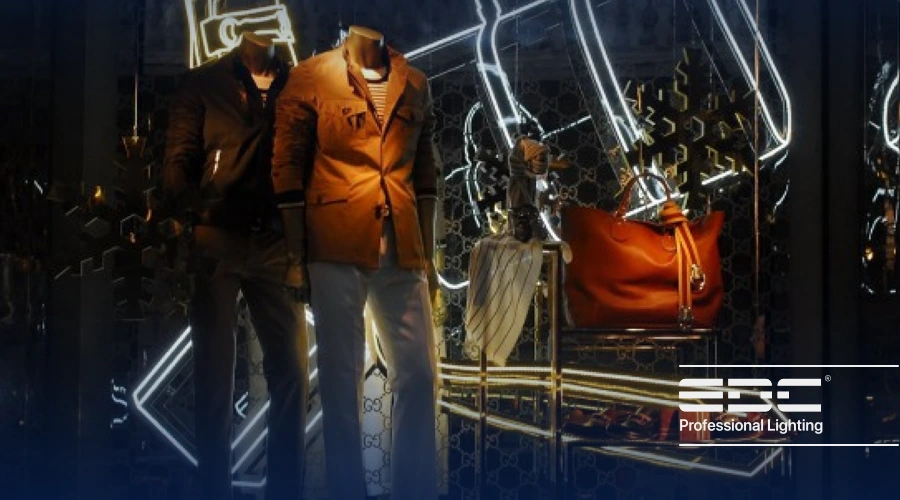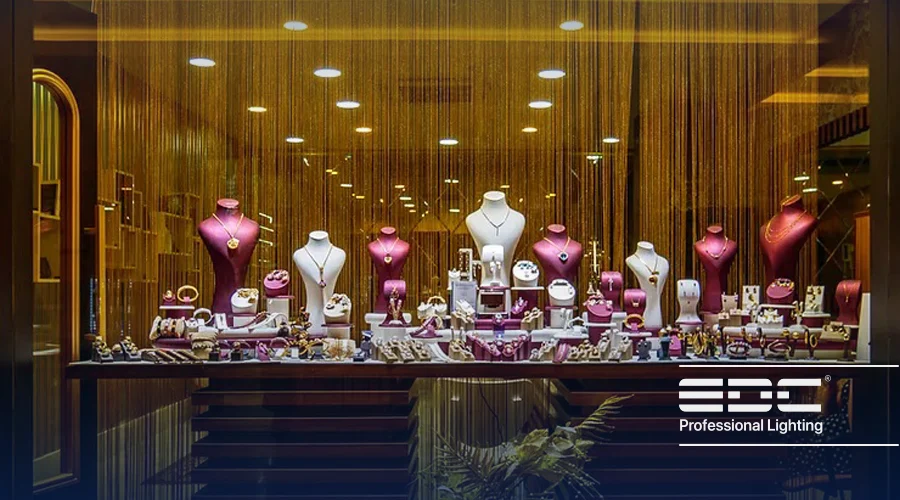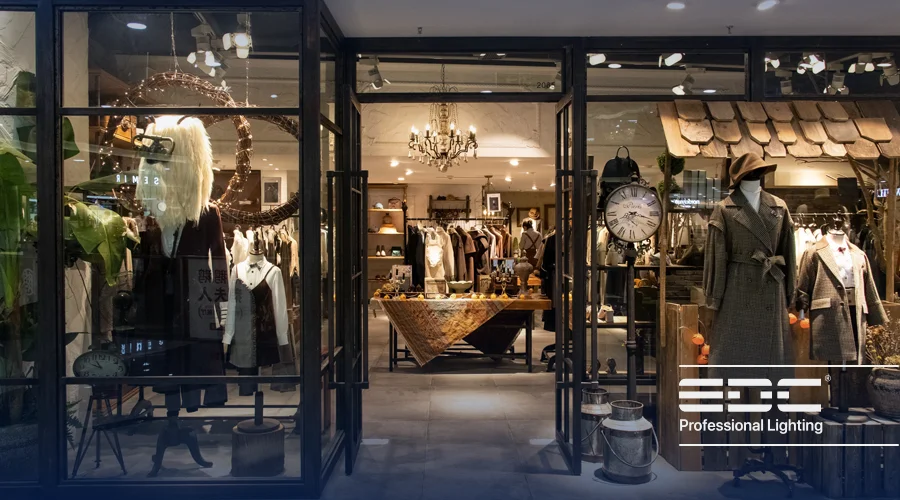In a busy and noisy world, the first thing that catches the attention of passers-by is the storefront. Shopfront lighting plays a key role in your sales and can lead customers into your store and significantly increase sales. In this article from EDC, we provide you with a complete guide to shopfront lighting so that you can familiarize yourself with its principles, methods and key points and be able to create stunning lighting for your store.
Why is shopfront lighting important?
Shopfront lighting plays an important role in attracting customers and increasing sales. Some of the reasons why shopfront lighting is important are:
Attracting attention: Proper lighting can draw the attention of passers-by to the shopfront and invite them into the store.
Highlighting products: Proper lighting displays products in the best way and doubles their appeal.
Create a pleasant atmosphere: Proper lighting can create a pleasant atmosphere in the storefront and make the shopping experience more enjoyable for customers.
Brand reinforcement: Creative lighting can showcase your brand identity and create a lasting impression in the minds of customers.
Principles of storefront lighting

The principles of shop window lighting are as follows:
First, it is important to determine the purpose of the shop window lighting. Do you want to highlight specific products? Or do you want to illuminate the overall space of the shop window?
The type of products you have will influence the choice of the type of shop window lighting. For example, for jewelry, you need subtle and precise lighting, while for clothing, you can use more general lighting.
The color temperature of the light can evoke different emotions in customers. For example, warm lights create an intimate atmosphere; while cool lights display a modern and stylish atmosphere.
The amount of light should be appropriate so that the products are clearly visible without irritating the eyes of customers. In addition, the lighting should be uniform so that there are no shadows or blind spots in the shop window.
What is the best lamp for a shop window?
Below, we will introduce the types of lights used in showcase lighting and the advantages and disadvantages of each:
1. LED shop showcase lights
Advantages:
Low energy consumption: LED lights use up to 90% less energy than incandescent bulbs.
Long lifespan: LED lights last longer than incandescent bulbs.
Color variety: LED lights are available in different colors and you can use them to create a specific theme or atmosphere.
Low heat generation: LED lights produce little heat and are therefore suitable for lighting sensitive products such as clothing and jewelry.
Adjustability: You can adjust the light intensity and color of LED lights.
Disadvantages:
High price: LED lights are more expensive than incandescent and halogen bulbs.
Temperature sensitivity: LED lights may have a shorter lifespan at high temperatures.
2. Halogen lights
Advantages:
Affordable price: The price of halogen lamps is lower than LED lights.
Strong light: Halogen lights produce concentrated light.
Variety of models: Halogen lights are available in different models and you can use them for different lighting.
Disadvantages:
High energy consumption: Halogen lights have high energy consumption and therefore increase electricity consumption.
High heat generation: Halogen lights produce a lot of heat and therefore are not suitable for lighting products such as clothing and jewelry.
Short life: Halogen lights have a shorter life than LED lights.
3. SMD lights
Advantages:
Very low energy consumption: SMD lights have very low energy consumption and therefore significantly reduce electricity consumption.
Uniform light: SMD lights produce uniform light without shadows.
Long life: SMD lights have a long life and therefore reduce your maintenance costs.
Disadvantages:
High price: SMD lights are more expensive than incandescent and halogen lamps.
Weak light: SMD lights have weaker light than halogen lights.
4. String for shop windows

Advantages:
Affordable price: The price of LED strip lights is lower than other lights.
Color variety: Strips for shop windows are available in different colors and you can use them to create a specific theme or atmosphere.
Flexibility: LED strips are flexible and you can use them for different lighting.
Easy installation: LED strips are easy to install and you can easily install them.
Disadvantages of LED strips:
Weaker light: LED strips have weaker light compared to some other lights, such as LED projectors.
Short lifespan: LED strips have a shorter lifespan than LED lights.
Light loss: Over time and with continuous use, the light intensity of LED strips may decrease.
Danger of damage: LED strips are delicate and may be damaged by impact or stretching.
Heat generation: Although LED strips produce less heat than incandescent and halogen bulbs, they still produce heat that can melt or damage sensitive materials.
Power supply required: You need a power supply to use LED strips, which is an additional cost.
5. LED spotlight
Advantages:
Strong light: New LED spotlights produce a focused beam.
High light output: For lighting large windows, purchasing an LED spotlight is recommended due to its high light output.
Adjustable: You can adjust the light intensity and color temperature of LED spotlights.
Disadvantages:
High price: LED spotlights are more expensive than other lights.
Average energy consumption: LED spotlights have an average energy consumption, which increases your electricity consumption.
Window Lighting Methods
There are various methods for lighting a store window, including:
General lighting: In this method, light-diffusing lights are used to illuminate the entire space of the window.
Combined lighting: In this method, a combination of spot and general lighting is used to achieve balance and depth in the window.
Decorative lighting: In this method, decorative and colored lights are used to create a special and attractive space.
Important points in window lighting
Choosing the appropriate method for lighting a shop window and store depends on several factors such as the location of the window, dimensions, type of products, lighting standards, type of light source, amount of illumination, angle of light radiation, and heat generated by light sources.
1. Window location
The lighting of window displays inside the arcade is different from window displays facing the street or window displays that are adjacent to each other. If you are in a row of similar stores, you should do the lighting in a way that is more attractive to the audience.
2. Showcase dimensions
The dimensions of the display case are influential in choosing technical parameters, equipment types, and lighting methods. The purpose of lighting is to create a visual effect to highlight the strengths of the store and products.
3. Type of products
The lighting of a jewelry store display case is different from that of a boutique or shoe store. For example, in boutique lighting, localized lighting is needed, while in counter or cashier lighting, general lighting is more appropriate.
4. Lighting standards

Paying attention to color, color psychology, audience gender and age, visual effect, and store identity are among the most important principles of lighting. Vertical light is recommended for store window lighting because it is more noticeable and has a greater impact. When choosing a color, attention should also be paid to the store architecture and the fashion world.
5. Type of light source
Light sources are divided into two categories: point and diffuse. Diffuse light sources are also divided into three subgroups: linear, spherical, and flat. Different light sources are used to display products according to the type and dimensions of the display case.
6. Amount of light
The type of product and the size of the display case are effective in the amount of light suitable for display case lighting. For luxury products and large stores, more lamps should be used.
7. Angle of light
The height and depth of the display case are effective in choosing the angle of light, the method of lighting, and the location of the lights. Light should be used in a way that highlights the key feature of the product. It is not appropriate to use limited light sources on tall shelves or display cases. If the ceiling height of the store is high, the beam angle should be sharp and sharp.
8. Heat generated by light sources
Light bulbs that do not produce much heat should be used. High heat can damage some products such as clothing.
Consult a lighting expert to find the best solution for your store. EDC offers lighting design and calculation services free of charge to customers. This service will help you choose the right number and type of lights you need, depending on the type of products, the area of the display case, etc.
Suitable lights for lighting different types of display cases
Below, we will introduce the suitable lights for lighting different display cases:
Jewelry and watch display cases: Use LED lights with concentrated light and high color index.
Clothing display cases: Use LED lights with diffused light and cool color temperature.
Furniture showcase: Use LED lights with warm, soft light.
Cosmetic showcase: Use LED lights with white light and high color rendering index.
Food showcase: Use LED lights with warm light.
Common mistakes in showcase lighting

Some common mistakes in storefront lighting are as follows:
Excessive lighting can irritate the eyes and deter customers from entering the store.
It is necessary that the type of lighting is appropriate for the type of products and the space of the storefront.
Decorative lighting can create a special and attractive atmosphere in the storefront.
Conclusion
Storefront lighting is a great opportunity to attract customers and increase sales. By considering the principles and tips mentioned in this article, you can create stunning lighting for your store with store decor lights and give a beautiful look to your products.